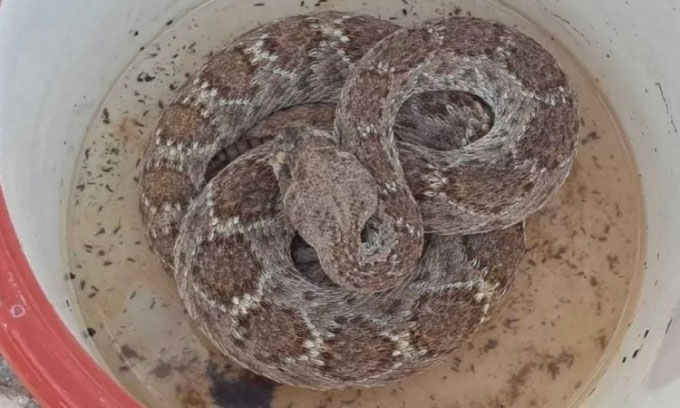A woman in Arizona discovers a malnourished rattlesnake trapped beneath her shed for over two years.
The snake was first spotted at the woman’s home in 2020, stealthily slithering around her yard. The homeowner quickly installed an electric fence along the base of the shed to prevent mice from entering, which would attract the snake for food. However, she did not realize that the snake had crawled underneath the shed.

The rattlesnake shows clear signs of malnutrition. (Photo: Rattlesnake Solutions)
“How this snake survived for such a long time remains a mystery to us,” Newsweek reported on October 20, quoting Bryan Hughes, owner of Rattlesnake Solutions, a company specializing in rattlesnake removal. “It’s possible that some prey, like small lizards, could squeeze through the 0.6 cm mesh of the fence, allowing the snake to go without food during that entire time.”
The Western Diamondback Rattlesnake is the largest rattlesnake species in Arizona, found throughout the southwestern region. In some cases, these snakes can grow up to 2 meters long. Their venomous bite can lead to blood clotting, internal bleeding, muscle damage, and tissue death.
According to Hughes, rattlesnakes often appear in homes in Arizona, primarily in yards where there are plenty of trees, water sources, and opportunities for feeding. Each day, Hughes’ team receives up to 30 calls for snake removal in the area. In the wild, rattlesnakes can survive for months without food and can live for a year or more without eating.
However, even so, two years is an excessively long time for a rattlesnake. When a snake becomes malnourished, its appearance can change significantly. In this case, the snake’s body fat and muscle mass had nearly disappeared, leaving only loose skin draped over its ribs. Dehydration and starvation also caused it to lose its venom glands, resulting in a hollow head instead of the broad arrowhead shape typically seen in viper family snakes. If the pressure to hunt and the energy required to digest a meal become too great for the rattlesnake, it may not survive.
Dave Holland, a snake catcher from Rattlesnake Solutions who rescued the animal, stated that it has the best chance of survival if returned to its natural environment rather than being kept in captivity elsewhere. Based on Holland’s assessment at the time, the best solution was to release the snake back into its native habitat as quickly as possible. They directly released it into a burrow, where the animal could explore safely and successfully hunt for food.


















































